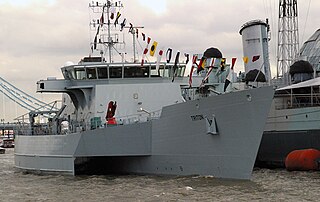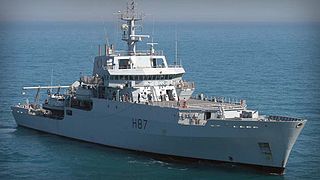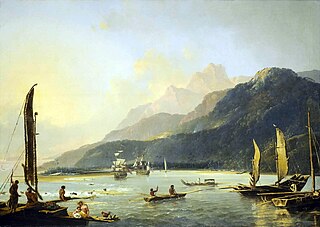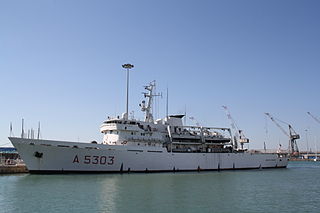
Sonar is a technique that uses sound propagation to navigate, measure distances (ranging), communicate with or detect objects on or under the surface of the water, such as other vessels.

The Research Vessel Triton is a trimaran vessel owned by Gardline Marine Sciences Limited and a former prototype British warship demonstrator for the UK's Defence Evaluation and Research Agency. She was built as a technology demonstrator ship for the Royal Navy's Future Surface Combatant, and has been used to both prove the viability of the hull-form and as a trials platform for other QinetiQ innovations. The ship was used by the Australian Border Force's Marine Unit, and was for a time moored in the River Fal near the King Harry chain ferry. Up until July 2019 she was moored on the River Yare, Great Yarmouth in Norfolk, England.

K-222 was the sole Project 661 "Anchar" nuclear-powered cruise-missile submarine of the Soviet Navy during the Cold War. Although the Soviets saw K-222 as an unsuccessful design, upon completion it was the world's fastest submarine and the first to be built with a titanium hull.

The Echo class was a class of multi-purpose hydrographic survey ships in commission with the Royal Navy. The ships were primarily tasked with conducting survey work in support of submarine and amphibious operations, however, the class also has a secondary role in mine countermeasures. The two vessels of the class were the most recent additions to the Royal Navy's Hydrographic Squadron. Each ship displaced approximately 3,700 tonnes, and was equipped with a state of the art suite of equipment. The lead ship of the class, HMS Echo, was retired in 2022 and her sister ship in 2023.

HMS Adventure was a barque that the Royal Navy purchased in 1771. She had been the merchant vessel Marquis of Rockingham, launched in 1770 at Whitby. In naval service she sailed with Resolution on James Cook's second expedition to the Pacific in 1772–1775. She was the first ship to circumnavigate the globe from west to east. After her return she served as a store ship until 1779. The navy sold her in 1783 and she resumed a civilian career, but retaining the name Adventure. She was lost in May 1811.

HMNZS Resolution (A14) was a hydrographic ship of the Royal New Zealand Navy (RNZN). Originally the United States Naval Ship USNS Tenacious (T-AGOS-17), the Stalwart-class ocean surveillance ship was used by the United States to locate and track Soviet submarines from 1989 to 1997, when she was transferred to the RNZN for use as a hydrographic survey ship. She served until 27 April 2012. She was subsequently sold to EGS Group, a private surveying company, and renamed RV Geo Resolution.

HMAS Leeuwin is the lead ship of the Leeuwin-class of hydrographic survey vessels operated by the Royal Australian Navy (RAN).

HMS Adventure, pennant number M23, was an Adventure-class minelaying cruiser of the Royal Navy built in the 1920s that saw service during the Second World War. Her commander between 1928 and 1929 was the future First Sea Lord John H. D. Cunningham. Laid down at Devonport in November 1922 and launched in June 1924, Adventure was the first vessel built for service as a minelayer; she was also the first warship to use diesel engines, which were used for cruising. Adventure first joined the Atlantic Fleet, then was transferred to the China Station in 1935. In World War II, the ship was damaged in 1941 and 1944, and was converted to a landing craft repair in 1944. In 1945 Adventure was reduced to reserve and in 1947 she was sold and broken up for scrap.

The Leeuwin class is a two-ship class of hydrographic survey vessels operated by the Royal Australian Navy (RAN). Leeuwin and Melville were ordered from NQEA in 1996, and were commissioned in 2000. The ships are capable of charting waters up to 6,000 metres (20,000 ft) deep, carry three Fantome-class survey boats, and could operate an AS 350B Squirrel helicopter. In addition to surveying duties, since 2001 both vessels have been used to supplement the RAN patrol force. Leeuwin is based at HMAS Cairns, while Melville was decommissioned in August 2024.

A multibeam echosounder (MBES) is a type of sonar that is used to map the seabed. It emits acoustic waves in a fan shape beneath its transceiver. The time it takes for the sound waves to reflect off the seabed and return to the receiver is used to calculate the water depth. Unlike other sonars and echo sounders, MBES uses beamforming to extract directional information from the returning soundwaves, producing a swathe of depth soundings from a single ping.

HMAS Melville is the second ship of the Leeuwin class of hydrographic survey vessels operated by the Royal Australian Navy (RAN). The ship was decommissioned on 8 August 2024.

Salvage diving is the diving work associated with the recovery of all or part of ships, their cargoes, aircraft, and other vehicles and structures which have sunk or fallen into water. In the case of ships it may also refer to repair work done to make an abandoned or distressed but still floating vessel more suitable for towing or propulsion under its own power. The recreational/technical activity known as wreck diving is generally not considered salvage work, though some recovery of artifacts may be done by recreational divers.
SS Rosehill, also known as SS Penhill, was a 2,788 GRT steel-hulled collier built in 1911 by S.P. Austin and Son of Sunderland under the name Minster. She was torpedoed by the Imperial German Navy submarine UB-40 in the English Channel off Fowey, Cornwall, England, on 23 September 1917 while en route from Cardiff, Wales, to Devonport. She was taken under tow but sank in Whitsand Bay at 18:05. Her wreck lies in 28 metres of water at 50°19.793′N4°18.520′W with her bow to the north.

The Bulldog class was a four ship class of survey vessels in service with the Royal Navy from the late 1960s until the start of the 21st century. Initially designed with service overseas in mind, they spent most of their careers off the British coast. A fifth ship was subsequently built to a modified design to support them in their activities. Decommissioned and sold off at the end of the 20th and start of the 21st centuries, they have continued in service as civilian vessels, with some being converted to private yachts and others entering other commercial sectors.

The Armoured Engineer Reconnaissance Vehicle (AERV) is an Indian military engineering vehicle developed by Defence Research and Development Organisation (DRDO) in coordination with C-TEC, as per General Staff Qualitative Requirements (GSQRs) of the Indian Army for enabling the combat engineers to conduct recce operations.

The Fantome class is a class of eight small survey motor boats (SMBs) operated by the Royal Australian Navy (RAN) and DMS Maritime. The four-man boats are designed to operate from the Leeuwin-class survey vessels, with three assigned to each ship, while the seventh and eighth were attached to the RAN Hydrographic School at HMAS Penguin. They are fitted with navigational and survey equipment and are unarmed.

The second voyage of James Cook, from 1772 to 1775, commissioned by the British government with advice from the Royal Society, was designed to circumnavigate the globe as far south as possible to finally determine whether there was any great southern landmass, or Terra Australis. On his first voyage, Cook had demonstrated by circumnavigating New Zealand that it was not attached to a larger landmass to the south, and he charted almost the entire eastern coastline of Australia, yet Terra Australis was believed to lie further south. Alexander Dalrymple and others of the Royal Society still believed that this massive southern continent should exist. After a delay brought about by the botanist Joseph Banks' unreasonable demands, the ships Resolution and Adventure were fitted for the voyage and set sail for the Antarctic in July 1772.

Ammiraglio Magnaghi is a hydrographic survey vessel in service with Italian Navy.

The Ninfe class of survey vessels consists of two catamaran hulls operated by the Marina Militare Italiana.

















